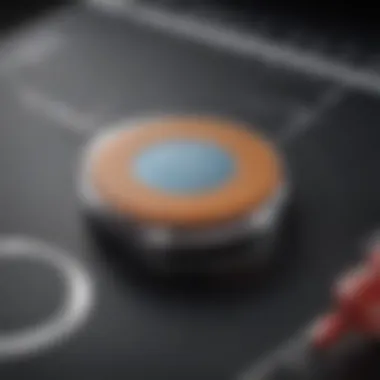Exploring Innovations in Glucose Check Patches


Intro
The advent of glucose check patches signifies a pivotal moment in diabetes management. These devices offer an innovative approach to monitoring blood glucose levels, which is essential for those living with diabetes. As technology evolves, understanding how these patches work and their implications for patient care becomes increasingly important. This article will delve into the underlying principles of glucose monitoring, recent research trends, and the regulatory landscape that shapes these advancements.
Key Concepts
Definition of the Main Idea
Glucose check patches are wearable devices designed to continuously monitor glucose levels in the skin. Unlike traditional finger-prick methods, which can be invasive and uncomfortable, these patches provide a non-invasive alternative. They utilize advanced biosensors that react to interstitial fluid, offering real-time data on blood glucose. This innovation not only enhances patient comfort but also improves the accuracy and frequency of glucose measurements.
Overview of Scientific Principles
The effectiveness of glucose patches relies on electrochemical sensors and microfluidics technology. When in contact with the skin, these patches analyze the glucose concentration in the interstitial fluid through biochemical reactions. Upon detecting glucose, the sensors generate an electrical signal proportional to the amount present. This signal is processed and often transmitted to paired devices such as smartphones or smartwatches for easy access to readings.
Current Research Trends
Recent Studies and Findings
Ongoing research continues to explore the effectiveness and reliability of glucose check patches. Recent studies suggest significant improvements in accuracy when compared to traditional monitoring methods. Additionally, studies have indicated that consistent monitoring can help patients manage their diabetes more effectively, leading to improved health outcomes.
Significant Breakthroughs in the Field
Several breakthroughs have emerged within this domain. For instance, the use of microneedle technology allows for more efficient and precise glucose monitoring without pain associated with hypodermic needles. Moreover, advancements in materials science are leading to the development of more durable and skin-friendly patch materials.
"These technological advancements are reshaping diabetes management, making it more accessible and user-friendly for millions around the world."
"These technological advancements are reshaping diabetes management, making it more accessible and user-friendly for millions around the world."
This exploration of glucose patches reveals not only their technical aspects but also the broader implications for patient care and quality of life in individuals managing diabetes.
Foreword to Glucose Check Patches
Glucose check patches represent an important innovation in the field of diabetes management. They utilize advanced technology to monitor glucose levels through a non-invasive approach. This article will explain how these patches function and their significance in improving patient care. The convenience and continuous monitoring offered by these devices are not mere enhancements; they are transformative. As patients manage their condition, the ability to have real-time insight into glucose levels can lead to better decision-making and, ultimately, improved health outcomes.
Definition and Purpose
Glucose check patches are wearable devices designed to continuously monitor glucose levels through the skin. They provide a method to measure glucose without the need for painful finger sticks. This feature makes them particularly appealing for patients who require frequent monitoring due to diabetes. The primary purpose of these patches is to supply timely data to users. This data can facilitate informed decisions regarding diet, exercise, and medication. Furthermore, the patches can send alerts when glucose levels fall outside of the target range, which can help avert serious complications.
Brief History of Glucose Monitoring
The evolution of glucose monitoring has made significant strides since the early days of diabetes management. The first glucose tests required large blood samples and were cumbersome. Over the years, technology has advanced from manual glucose meters to modern continuous glucose monitoring systems.
In the 1980s, the advent of portable glucose meters allowed patients more freedom. However, these devices still required finger pricks. The introduction of continuous glucose monitors in the late 1990s marked a notable change. These systems enabled users to track glucose levels in real time but included wires and sensors that might be cumbersome or uncomfortable. Today, glucose check patches are emerging as the next evolution. They promise a hassle-free and more comfortable method of monitoring, aligning well with patients’ needs for convenience and efficiency.
The Technology Behind Glucose Check Patches
The examination of glucose check patches is incomplete without understanding the technology that powers them. These advanced devices play a crucial role in diabetes management, offering patients a user-friendly experience for regular monitoring. The effectiveness of these patches is intimately connected to the underlying technology, which encompasses elements such as sensor technology, data transmission methods, and wearable design considerations. Each of these components contributes to the overall enhancement of patient care and the efficacy of glucose monitoring.
Sensor Technology
Sensor technology is fundamental to glucose check patches. These sensors are designed to detect glucose levels in interstitial fluid, providing a close approximation of blood glucose concentrations. There are several types of sensor technologies used, including enzyme-based sensors that rely on specific enzymatic reactions to detect glucose. They convert glucose oxidation into an electrical signal that can be interpreted by a connected device. This method tends to offer high accuracy and reliability.
Another advancement in sensor technology is the use of non-invasive methods. Optical sensors, which use light to measure glucose, are being developed to minimize discomfort. This innovation has the potential to enhance user experience significantly.


Additionally, sensors utilized in glucose patches today are often equipped with a range of features, such as automated calibration and built-in error correction algorithms. These advancements help mitigate some common accuracy issues faced previously, ensuring a more reliable everyday monitoring tool for users.
Data Transmission Methods
Data transmission methods play a critical role in the functionality of glucose check patches. Modern devices typically leverage wireless communication protocols, such as Bluetooth or NFC (Near Field Communication). This connectivity method enables swift transfer of data from the patch to a smartphone or dedicated monitoring device.
Utilizing Bluetooth Low Energy (BLE) is particularly beneficial as it allows for prolonged battery life while maintaining a stable connection. Continuous data flow is essential for real-time monitoring, which can alert users to fluctuations in glucose levels without delay.
Moreover, some patches may incorporate cloud technology to aggregate data over time. This ability enables healthcare providers to analyze the data remotely, facilitating better management of the patient's condition. Such integration ensures more informed decisions about treatment and adjustments to insulin delivery.
Wearable Design Considerations
The design of glucose check patches is as significant as the technology itself. Wearable design considerations encompass several factors including comfort, aesthetics, and usability. Patches must be lightweight and flexible, enabling users to wear them for extended periods without discomfort. Fabrics that are breathable and hypoallergenic are essential to minimize skin irritation.
In addition to physical comfort, the appearance of patches matters too. A well-designed patch can enhance user acceptance, especially among younger patients who may be self-conscious about medical devices. With various designs and colors, manufacturers aim to create a product that seamlessly integrates into a person's lifestyle.
Usability also plays a vital role. Patches need to be easy to apply and remove. Furthermore, user interfaces on connected devices must be intuitive. A user-friendly experience encourages consistent use, which is crucial for effective diabetes management and control.
"The effectiveness of glucose monitoring is heavily dependent on both technology and design. A well-rounded approach ultimately benefits patients most."
"The effectiveness of glucose monitoring is heavily dependent on both technology and design. A well-rounded approach ultimately benefits patients most."
Clinical Applications of Glucose Check Patches
Clinical applications of glucose check patches are a critical component in the ongoing evolution of diabetes management. These patches offer unique solutions for continuous glucose monitoring, which is essential for individuals managing diabetes. They enable users to keep track of their glucose levels without the need for multiple finger pricks. The ability to monitor glucose levels in real-time provides immediate feedback about the user’s metabolic state. This has significant implications for patient outcomes, lifestyle choices, and overall healthcare costs.
Real-time Monitoring
Real-time glucose monitoring is one of the most vital benefits offered by glucose check patches. These patches use sophisticated sensors to detect changes in blood glucose levels instantaneously. This immediacy allows patients to make swift decisions regarding their treatment plans. For instance, a sharp drop in glucose levels can trigger alerts, prompting users to take corrective actions such as consuming carbohydrates. Studies have shown that real-time monitoring helps in reducing hypoglycemic incidents, ultimately leading to improved patient safety.
Moreover, continuous data collection opens avenues for better trend analysis. Over time, healthcare providers can use this data to identify patterns and adjust treatment protocols accordingly. This approach moves diabetes management from a reactive model to a proactive one, empowering patients with valuable insights into their health.
Integration with Insulin Delivery Systems
Another promising application of glucose check patches is their integration with insulin delivery systems. Devices like the Omnipod and Medtronic's insulin pumps exemplify how real-time data can enhance insulin delivery. When glucose patches communicate with these devices, they can automatically adjust insulin dosages based on current glucose readings. This seamless integration reduces the burden on the patient and promotes optimal glycemic control.
The collaborative function between glucose patches and insulin pumps also minimizes risks. By providing accurate, real-time data, these systems can prevent possible overdoses or missed doses. This reliability is crucial in maintaining the delicate balance required by diabetic patients. Hence, the connection between glucose monitoring and insulin delivery is becoming a cornerstone in modern diabetes care.
Potential for Enhanced Patient Engagement
The potential for enhancing patient engagement is another significant aspect of glucose check patches. Traditional methods of glucose monitoring often feel like an additional chore, leading to patient frustration and non-compliance. In contrast, glucose patches can be easier to use and less intrusive, increasing the likelihood of regular monitoring.
Moreover, many glucose check patches come equipped with mobile applications that allow users to visualize their glucose data. This user-friendly interface not only educates but motivates patients to take an active role in managing their condition. Engaged patients are generally more proactive about adhering to treatment plans, attending regular check-ups, and making necessary lifestyle changes. Educational tools integrated within these applications can further enhance understanding and development of better health practices.
"Continuous glucose monitoring fundamentally transforms how patients interact with their health, making daily management less burdensome and more insightful."
"Continuous glucose monitoring fundamentally transforms how patients interact with their health, making daily management less burdensome and more insightful."
Regulatory Landscape
The regulatory landscape surrounding glucose check patches is crucial for ensuring their safety, effectiveness, and market readiness. This section examines two essential components of this landscape: the FDA approval process and the international standards and regulations that govern these devices.
FDA Approval Process


The FDA approval process serves as a vital checkpoint for glucose check patches. It mandates rigorous testing and evaluation to ensure that these devices meet safety and performance standards before reaching consumers. The process often involves several phases, including preclinical studies, clinical trials, and a final evaluation of the data collected.
- Preclinical Studies: Initial tests are done in laboratories and through animal testing. Here, researchers assess the basic functionality of the glucose check patches, focusing on their ability to accurately measure glucose levels.
- Clinical Trials: These trials involve human participants and provide critical data on effectiveness and user experience. Participants wear the patches while researchers monitor their performance against traditional glucose monitoring methods.
- Review and Approval: Once data is submitted to the FDA, it undergoes a thorough review. Approval can take time, ensuring that all necessary criteria are met. This rigorous process builds trust among users and healthcare providers, ensuring that approved devices have undergone sufficient scrutiny.
International Standards and Regulations
Beyond the FDA, various international standards and regulations play a pivotal role in the regulation of glucose check patches. These guidelines help harmonize practices worldwide, ensuring a level of consistency in device quality.
- ISO Standards: The International Organization for Standardization (ISO) sets standards related to medical devices, emphasizing safety, efficacy, and performance. ISOs 13485 and 14791 are particularly relevant, addressing quality management systems and risk management.
- CE Marking: In Europe, glucose check patches must obtain a CE marking before they can be marketed. This mark indicates compliance with health, safety, and environmental protection standards. Manufacturers must provide evidence of their product's compliance to secure this mark.
- Global Variances: While many countries follow similar guidelines, some regulations may vary significantly. It's essential for manufacturers to navigate these differences to ensure global market access. This consideration is critical as it can impact the availability and affordability of these patches for patients in various regions.
"Understanding the regulatory landscape is essential to appreciate the complexities of introducing new glucose monitoring technologies to the market."
"Understanding the regulatory landscape is essential to appreciate the complexities of introducing new glucose monitoring technologies to the market."
Through a comprehensive understanding of the FDA approval process and international standards, one can appreciate the efforts invested in bringing safe and effective glucose check patches to diabetic patients. Such diligence not only fosters innovation but also builds confidence in the evolving field of diabetes management.
Market Trends and Dynamics
Understanding the market trends and dynamics surrounding glucose check patches is crucial for grasping their role in modern diabetes management. This section will explore significant elements that shape the industry such as current market leaders, emerging competitors, and the evolving preferences of consumers.
Current Market Leaders
The market for glucose check patches has been rapidly developing, with several prominent players establishing a strong foothold. Leading companies such as Dexcom, Abbott Laboratories, and Medtronic have taken center stage by offering innovative solutions tailored for diverse patient needs. Each of these organizations has made considerable investments in research and development, allowing them to advance their technologies effectively.
- Dexcom, for instance, is recognized for its continuous glucose monitoring (CGM) systems, which provide real-time glucose level data.
- Abbott Laboratories offers the FreeStyle Libre system, which features a sensor that can be scanned for quick glucose readings.
- Medtronic focuses on integrating glucose monitoring with insulin delivery systems, enhancing overall diabetes management.
These companies not only lead in market share but also set trends in technology, compliance, and user-interface design.
Emerging Competitors
Alongside established market leaders, new entrants are influencing the competitive landscape for glucose monitoring technologies. Startups and smaller companies are bringing fresh ideas and approaches to the industry. Companies like Senseonics and GlucoWise are making strides by researching and developing innovative systems, such as implantable sensors and non-invasive glucose monitoring.
Their focus on unique technologies presents opportunities for patients seeking alternatives and might compel larger competitors to innovate further. Additionally, these competitors may pave the way for improvements in user experience and accessibility, addressing some of the existing shortcomings in current offerings.
Consumer Preferences and Trends
Shifts in consumer preferences significantly impact the development and marketing strategies of glucose check patches. Patients now prioritize not only accuracy but also ease of use and comfort. Often, users are involved in the decision-making process regarding which products to adopt based on personal experiences and recommendations.
Key trends observed include:
- Demand for Non-invasive Monitoring: More patients prefer devices that do not require finger pricks, leading to a push for innovative monitoring solutions.
- Integration with Mobile Technology: Consumers are looking for devices that seamlessly integrate with smartphones and health apps for better management and tracking.
- Sustainability Concerns: Increasingly, users are becoming aware of the environmental impact of medical devices. As a result, companies that emphasize sustainable practices may gain a competitive edge.
Research indicates that consumer input is paramount in shaping product features and marketing initiatives in the glucose monitoring space.
Research indicates that consumer input is paramount in shaping product features and marketing initiatives in the glucose monitoring space.
In summary, analyzing these market trends and dynamics provides insight into the future trajectory of glucose check patches. Being aware of the current leaders, emergence of new players, and evolving consumer demands allows stakeholders to tailor their strategies effectively. Such understanding is vital for enhancing patient care and advancing diabetes management technologies.
Challenges and Limitations
The deployment of glucose check patches in diabetes management introduces several challenges and limitations that are crucial to address. While these devices offer innovative solutions for monitoring, their effectiveness and overall adoption rely on a few key areas. Understanding these challenges is essential for stakeholders in the healthcare sector, including patients, researchers, and manufacturers.
Accuracy and Reliability Issues


One primary concern surrounding glucose check patches is the accuracy of the readings they provide. Patients depend on these patches for real-time data, which is critical for effective management of their condition. However, factors such as sensor calibration, environmental interference, and individual physiological differences can affect reliability. The variances in glucose measurement can lead to inappropriate insulin dosing or dietary decisions, posing risks to patient safety. A study found that inaccuracies of more than 15% in glucose readings can significantly impact treatment outcomes. Continuous quality monitoring and improvements in sensor technology are key to enhancing the reliability of these devices.
Cost and Accessibility
Cost remains a significant barrier to the widespread adoption of glucose check patches. High prices can limit access for many patients, especially those without comprehensive health insurance coverage. For instance, patients may have to choose between these advanced monitoring systems and other essential health expenditures. Additionally, the disparities in healthcare access across different socioeconomic groups highlights the importance of making these technologies more affordable. Strategies could involve partnerships between manufacturers and healthcare providers to reduce retail prices or offer subsidized options for low-income patients.
User Adoption Barriers
Despite the benefits that glucose check patches present, some patients exhibit hesitance in adopting this technology. Psychological factors, such as fear of the unknown or discomfort with wearing devices, may pose challenges. Moreover, there can be a lack of understanding of the operational aspects of the patches, leading to reluctance in their use. Education plays a pivotal role in overcoming these barriers. Patient education programs that emphasize the ease of use, the benefits of real-time data, and support resources can help ease the transition.
"The successful implementation of glucose check patches hinges not only on their technology but also on addressing user concerns, financial barriers, and accuracy issues."
"The successful implementation of glucose check patches hinges not only on their technology but also on addressing user concerns, financial barriers, and accuracy issues."
In summary, while glucose check patches hold promise for enhancing diabetes management, it is essential to address their challenges head-on. Continued research and development efforts are needed to ensure these devices meet the demands of users and contribute effectively to controlling glucose levels.
Future Directions in Glucose Monitoring Technologies
The landscape of glucose monitoring stands on the precipice of a revolutionary shift. Future directions in glucose monitoring technologies signify innovative pathways that promise to reshape how diabetes management occurs. With evolving technologies, the integration of advancements not only enhances monitoring accuracy but also improves user engagement. Moreover, this section explores emerging trends that could influence the outlook of diabetes care as a whole.
Advancements in Sensor Technology
Recent developments in sensor technology are pivotal, ushering in greater precision. New materials, such as flexible electronics, are now being utilized to create sensors that are both effective and adaptable. These sensors can provide real-time data, making them essential for proactive diabetes management. The accuracy and sensitivity of these sensors are also improving, allowing for smaller samples of blood to provide trustworthy results.
Furthermore, miniaturization plays a critical role. The development of smaller, wearable patches increases comfort for users while ensuring consistent and reliable data collection. Enhanced biocompatibility is another factor contributing to user satisfaction, reducing irritation or allergic reactions that sometimes occurred in earlier models of glucose monitoring systems.
Integration with Artificial Intelligence
The incorporation of artificial intelligence in glucose monitoring technologies is set to significantly transform user experiences. AI algorithms can analyze patterns in glucose levels, predicting fluctuations and assisting users in making informed decisions about diet, activity, and insulin administration. This capability allows for a more personalized approach to diabetes management.
As AI continues to evolve, the possibility of predictive analytics enhances the potential for automated alerts. Users could receive notifications on their devices before dangerous glucose levels occur. This level of proactive care can significantly reduce emergency health situations. However, the implementation of AI also raises concerns about data privacy and the security of sensitive health information, which necessitates robust measures to mitigate risks.
Potential for Mobile Health Applications
Mobile health applications represent another promising frontier for glucose monitoring. These applications can serve as hubs for data aggregation, where users can input their glucose levels, dietary habits, and physical activities. Such platforms encourage comprehensive self-management by providing users with insights into daily trends and patterns. This data can be invaluable for both patients and healthcare providers alike.
Moreover, the integration of community support features can assist users in feeling less isolated in their management journeys. Connected platforms that enable sharing of experiences, tips, and challenges show considerable potential to enhance user engagement. The challenge lies in ensuring that these applications are user-friendly and accessible to a broad audience.
"As the field of diabetes management evolves, the integration of technology and healthcare will become increasingly essential for effective patient outcomes."
"As the field of diabetes management evolves, the integration of technology and healthcare will become increasingly essential for effective patient outcomes."
Ending
The conclusion serves a pivotal role in any scholarly discussion, consolidating the essential findings while contemplating their broader implications. In the context of glucose check patches, this final section allows for an overview of significant insights gained throughout the article. It also stresses the advancements in diabetes management technology that these devices represent.
Summary of Key Findings
The exploration of glucose check patches highlights several fundamental aspects:
- Innovative Technology: Glucose check patches utilize advanced sensor technologies, making monitoring more accessible and accurate for patients.
- Clinical Integration: These patches not only enhance real-time glucose monitoring but also integrate seamlessly with additional diabetes management systems, such as insulin delivery devices.
- Regulatory Framework: The complex regulatory landscape governing these devices underscores the need for stringent standards to ensure safety and efficacy.
- Market Growth: A variety of companies are emerging as leaders in this market, addressing diverse consumer needs and preferences.
- Challenges: Issues related to accuracy, costs, and user acceptance remain but are being actively addressed by ongoing research and development.
"The rise of glucose check patches not only shapes the future of diabetes care but challenges conventional methods of health monitoring."
"The rise of glucose check patches not only shapes the future of diabetes care but challenges conventional methods of health monitoring."
Implications for the Future of Diabetes Management
Looking ahead, glucose check patches are positioned to transform diabetes management significantly. Their potential advancements include:
- Broadened Accessibility: As technology advances, it is likely that these patches will become more affordable, increasing accessibility for a wider range of patients.
- Enhanced Real-Time Data: Integration with artificial intelligence could refine data analytics, providing patients with actionable insights backed by predictive modeling.
- Mobile Health Applications: The potential for connected mobile health tools will empower users to monitor their glucose levels dynamically, fostering proactive health management.







